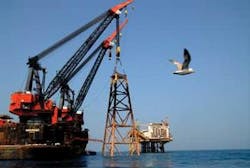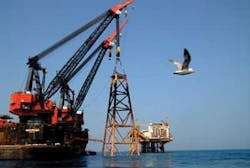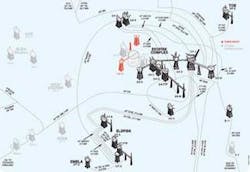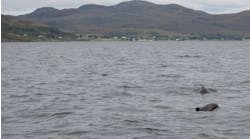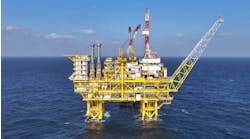Nick Terdre, Contributing Editor
The final chapter of the Ekofisk I cessation program in Norway is about to begin following the award of a contract for the removal of nine platforms, with options, to Heerema Marine Contractors. Offshore removal operations are due to start next year and to be concluded by 2013. Onshore recycling and disposal, which Heerema has subcontracted to AF Decom, is scheduled to be completed by 2014.
Most of the platforms ceased operations in 1998, when the second phase of Ekofisk development came onstream, and the others prior to that date. The planning for this extensive decommissioning campaign began in the early 1990s, so by the time it has been completed, the whole operation will have taken about 20 years.
The Ekofisk cessation plan, which also includes redundant facilities at the satellite Albuskjell, Cod, and Edda fields, was submitted in 1999 and the part relating to platform removal was approved by the Norwegian government in 2001.
The whole scheme, which also includes decommissioning the Ekofisk Tank and removing and disposing of light structures, was costed in 1998 at NKr 8 billion ($1.48 billion). ConocoPhillips declines to give an updated figure, but Mark Miller, general project manager, North Sea Cessation, acknowledges that the cost of services is now considerably higher than 10 years ago. Platform removal is one of the big-ticket items in the cessation plan cost.
While the Ekofisk cessation operation has hit the headlines as the single most extensive decommissioning project in the history of the offshore oil and gas industry, in parallel the field has also been a regular source of news regarding a continuing wave of development. The major redevelopment in 1998 was followed by Ekofisk Growth, which came on stream in 2005, and now ConocoPhillips is gearing up for a further significant investment in new production facilities. Bids for FEED studies were submitted in July. The company believes production could continue to around the middle of the century.
The tender for the main platform removal contract was issued in December 2005, with Heerema announcing its award this March. Its bid was the most attractive overall, says Miller. The extensive time taken to make the award was due to the contract’s wide scope, he adds, and the need for thorough discussion at all levels of the company and its partners in Ekofisk.
One factor weighing in Heerema and AF Decom’s favor was ConocoPhillips’ satisfaction with their performance to date on a NKr 400 million ($73.9 million) contract awarded in 2005 to remove light structures – flare stacks, bridges, and tripod supports – linked to installations at the center and the satellite platforms.
The nine base-scope platforms for the new program are 2/4 D, 2/4 P, and 2/4 R, all at or around the Ekofisk center; the two Albuskjell platforms 1/6 A and 2/4 F; Cod 7/11 A, Edda 2/7 C; and two booster platforms, 36/22 A and 37/4 A, both in the UK sector on the route of the Norpipe oil pipeline. Two of Heerema’s crane barges will share the removal work:Thialf will be used at the Ekofisk center where its dynamic-positioning capability will enable it to operate without anchoring, while Hermod will be deployed for the outlying and remote structures.
Two more platforms, 2/4 H and 2/4 Q, are among the options in the contract. Both are living quarters facilities still in use, so they cannot be decommissioned before a planned new accommodation platform, 2/4 L, is in place. This will be a large installation, with around 500 beds. FEED work is currently out to bid.
The jacket of Gassco’s 2/4 S riser platform is also an option. This platform was connected previously to the Ekofisk Tank via 2/4 R; Statoil, the original operator, removed the topsides and bridge in 2001 using theThialf following concerns about subsidence. Gassco’s redundant H-7 booster platform, in the German sector on the route of the Norpipe gas pipeline, is likewise a contract option, but no agreement has yet been signed, according to ConocoPhillips. A possible third-party candidate is BP’s 2/4 G, another riser platform bridge-linked to the Ekofisk Tank, but this is not yet a contract option and further discussions are required between the two parties.
Offshore work has been split into four stages, Miller says. All the platforms were abandoned and left in a cold state several years ago. The first stage, therefore, requires offshore surveys to check platform data and to confirm inventories. The second stage involves a make-safe operation to establish access, mount hand-rails, install fire-fighting equipment and ensure the removal work can be done safely. AF Decom will perform most of this work. The third and fourth stages are respectively topsides and jacket removal, which will primarily involve Heerema.
The first stage already has been carried out for the first four platforms to be removed – 2/4 P, 2/4 R, 36/22 A, and 37/4 A. Make-safe operations will be executed on the two booster platforms this summer, with theHermod deployed to lift equipment on board. The crane barge was expected to arrive in August, after completing topsides removal operations on BP’s North-West Hutton platform in the UK sector.
Make-safe for 2/4 P and 2/4 R is expected to take place in late 2008/early 2009. The 2/4 P is bridge-linked to the Tank and therefore the only source of access to the Tank, where decommissioning operations are still in progress. The removal of some 26,000 metric tons (28,661 tons) of topsides structures and equipment was completed last year, and operations to clean the storage tanks, which were partly carried out prior to the topsides removal, are set to resume in September, concluding by year-end. So the bridge-links between both 2/4 P and 2/4 R will only be removed next year, when the topsides of the two platforms, plus the P jacket, will be taken away. The topsides of the two booster platforms are also scheduled for removal in 2009, followed in 2010 by the jackets of the booster platforms and 2/4 R.
A preliminary schedule for the remaining five platforms has been drawn, but is subject to annual review and agreement with Heerema. At the start of 2009, the parties will agree the full work-scope for 2010, and so on through the term of the contract. This stipulates that the jacket of each platform is to be removed no later than one year after the topsides, so some elements for a given year are known in advance, Miller says.
Topsides removal will be reverse installation involving a series of module lifts – there will be no piece-small process. The first steps in stage three will consist of making the necessary cuts to free the modules for lifting and providing any stiffening needed. In some cases it will be possible to lift two modules at once. In general, the jackets will be cut into two pieces horizontally, though some of the larger ones will be sliced into three.
The base plan is to use the heavy-lift vessels to transport modules and jacket parts to AF Decom’s disposal site at Raunes in western Norway, though some will go on cargo barges. The HLV will be needed at Raunes in any case to lift the modules ashore. Raunes is roughly 350 km (217 mi) from the Ekofisk field, equivalent to a couple of days’ sailing.
The Edda and Albuskjell platforms are the largest. The Edda topsides weigh more than 12,000 metric tons (13,228 tons) while both Albuskjell topsides are more than 11,000 metric tons (12,125 tons). The two Albuskjell jackets both weigh more than 5,000 metric tons (5,511 tons).
The platform removal contracting process provided an opportunity for companies offering new single-lift technology to secure decommissioning work. In fact the first such opening also came from ConocoPhillips, which has been instrumental in supporting the development of this technology as a potential means of reducing removal costs.
In 2003, the company tendered a contract exclusively to single-lift contractors to remove the two booster platforms. After reviewing bids, however, it decided to cancel the tender mainly on the grounds that it was not convinced that the bidders had sufficient resources to fulfill all tender requirements.
For the current contract, several single-lift players were invited to bid. “The inclusion of certain single-lift companies on the platform removal bid list was the result of a thorough prequalification process,” says Miller. It is understood that one of these bidders, Monitor, was on the final shortlist of two. In late 2007, the contractor issued a press release announcing that its bid had been unsuccessful. “We still feel that this technology has a future,” he adds, “though with respect to this particular contract we concluded that the Heerema package was the most advantageous.”
The safety record during the Ekofisk cessation operations has been very good, with strongly positive trends in recent years. There were numerous lost-time incidents (LTIs) in the late 1990s but since 2001 the recordable record has been limited to medical treatment cases on an infrequent basis. The cessation project employs the Smarter Together program which it compiled in cooperation with the Sintef research institute to raise safety awareness, and implements Personal Safety Involvement training both for its own staff and contractors’ employees.
Three of the platforms in the Ekofisk cessation plan are not included in the current program of removals. The 2/4 A and 2/4 B wellhead platforms remain in operation and it is not yet known when they will be shut down. A third installation, 2/4 FTP (field terminal platform), ceased operations in 2007 but still functions as a riser platform.
Meanwhile, another platform is about to become redundant. This is the water injection platform 2/4 W, which ConocoPhillips recently announced is to be replaced by subsea water injection wells.
